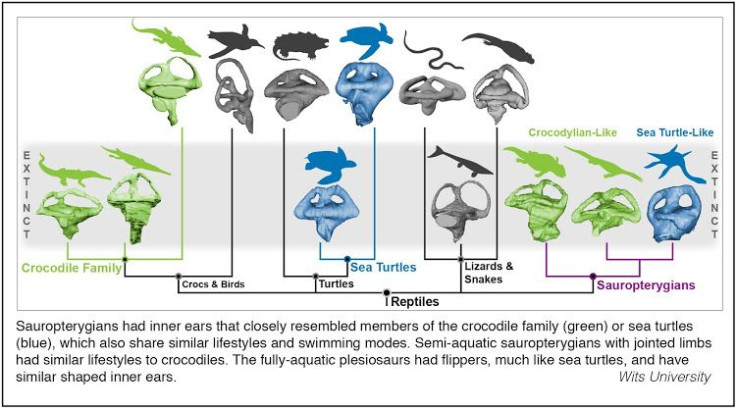Ancient Marine Reptiles' Inner Ear Very Similar To Crocodiles', Sea Turtles': Study

Researchers have now found that some marine reptiles that roamed our waters millions of years ago had very similar inner ears to modern day aquatic animals like whales, sea turtles and other marine animals.
The inner ear is a tiny but incredibly important part of any animal's body. It universally helps maintain balance and three dimensional orientation, and spatial analysis which help judge movement.
The team from the Wits University in South Africa studied fossils of reptiles called sauropterygians from millions of years ago and found several similarities to current day aquatic animals with regards to their inner ears.
The inner ear proportions of these ancient reptiles matched those of modern day crocodiles and whales who move very similarly in the way their ancient inner ear doppelgangers did.
Sauropterygians are unique animals to study because they belong to a diverse taxon of aquatic reptiles that evolved from terrestrial ancestors soon after the end-Permian extinction and flourished during the Mesozoic period before they became extinct at the end of that era.
They were one of the first completely marine reptiles and different species of Sauropterygians are united by a radical adaptation of their pectoral girdle — a bone and muscle system found behind the head that supports the upper body limbs in animals — which helped the creature make powerful flipper strokes most famously recognized in species such as pliosaurs.
James Neenan, a Postdoctoral Fellow at the Evolutionary Studies Institute at Wits University said in a press release on Brinkwire that "a completely extinct group of marine reptiles called sauropterygians (swimming reptiles from the age of dinosaurs) evolved similar inner ear proportions to those of some modern day aquatic reptiles and mammals."
"Sauropterygians are completely extinct and have no living descendants‚ so I was amazed to see that nearshore species with limbs that resemble those of terrestrial animals had ears similar to crocodylians and that the fully-aquatic‚ flippered plesiosaurs had ears similar to sea turtles," he added.
These plesiosaurs evolved into different groups. They branched into sea turtles, crocodiles and other sea reptiles but also gave modern day whales their body shape. This is because the "pliosauromorphs" that evolved from plesiosaurs had enormous heads and very short necks, a body shape that is shared by modern whales.

Whales have very small inner ears compared to their size. Their inner ears are comparable to humans who are much, much smaller.
The team say that the new study helped establish that the small inner ear size could be because of having such a short neck. Neenan and colleagues have now shown that "pliosauromorph" plesiosaurs also have a reduced inner ear size, supporting this idea.
"Nearshore sauropterygians swam in a similar way and had comparable lifestyles to modern-day crocodiles so had similar inputs on the inner ear organ," Neenan said.
"Plesiosaurs also 'flew' under water with similar flippers to those of sea turtles‚ so it’s not surprising that the organ of balance and orientation evolved to be a similar shape between these unrelated groups," Neenan concluded in the report.
The research was published on Dec. 7 in the journal Current Biology.
© Copyright IBTimes 2025. All rights reserved.



















